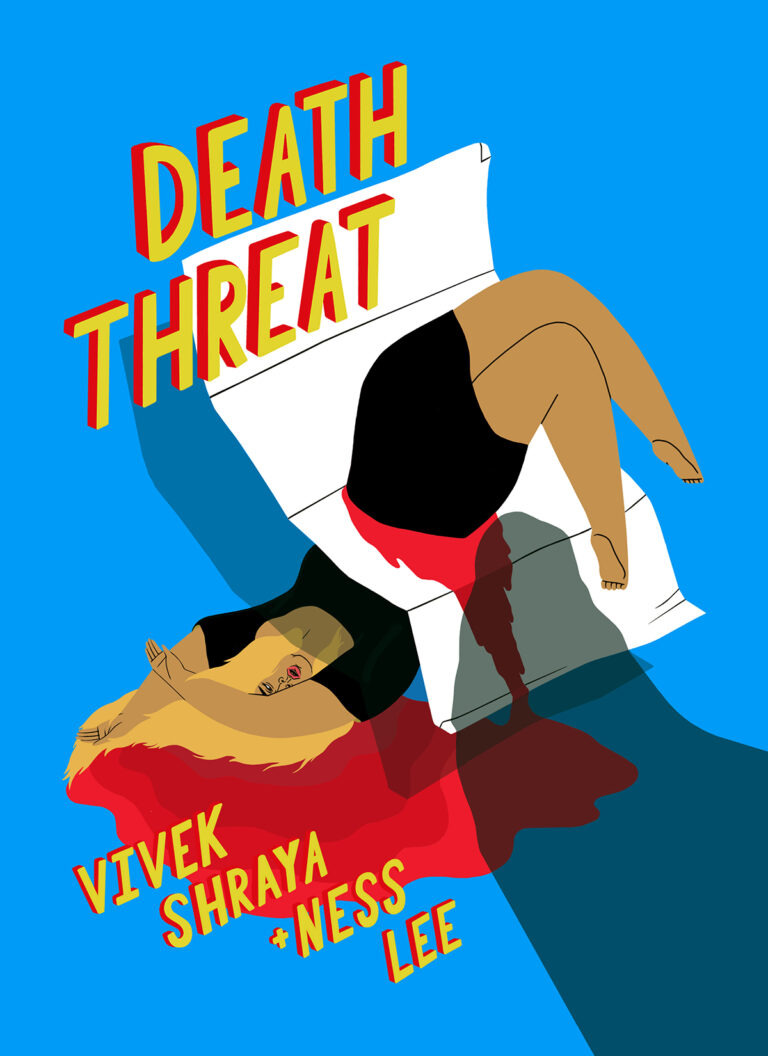In 2017, trans Canadian writer and musician Vivek Shraya began receiving hate mail from an online stranger. The stranger is cruel and condescending, and they are not hiding. Each email is signed with a full name and an address. Like Shraya, readers are left to wonder: is this intended as a further intimidation? To remind Shraya (and readers) that this intense, unprovoked hatred is, in fact, attached to a real person? It is truly haunting, and Shraya’s attempts to shake it off and laugh about it with her friends are entirely relatable. Her deflections are met with three additional emails, each more upsetting than the last, and, unfortunately, the online assailant is never found and arrested for their crimes. An artist, Shraya processes this experience by writing the graphic memoir Death Threat, drawn by Ness Lee.
At seventy-four pages, Death Threat moves quickly, though this often made it difficult for me to connect with Shraya. The majority of the visuals are told in single-paneled pages, and most instances of more than one panel on a page are to show dialogue or a series of actions. This leaves readers without any real context for Shraya’s inner self and/or her professional life, even though they catch glimpses here and there of her “everyday” — Ness draws her teaching, writing on a chalkboard, and her posts for some social networking sites. But with a book so focused on Shraya’s personal life, it’s hard to get a sense of the contours of her fame and how she might have appeared on her harasser’s radar. If readers want to know who Vivek Shraya is, they have to research her themselves before reading the book. After a quick internet search, I discovered that Shraya, a Canadian person of color, is a creator best known for her accomplishments in music, literature, and the visual arts.
Of course, as an autobiographer, Shraya determines how nonfiction events are framed, and if she doesn’t want to introduce herself to newcomers, that’s an artistic choice to be respected. But another issue comes to light when the story as a whole is analyzed. Three-quarters of the way though the book, right after Shraya receives the fourth and final hate mail in the story, she comes up with the idea to turn this nightmarish experience into a graphic novel. The catalyst for this is a possible throwaway comment in the aggressor’s most recent missive. It reminds Shraya of one of her own album titles, the cover of which was illustrated by Ness Lee. Shraya calls Lee and they begin working on the book together. The final quarter of the book devolves into how they are going to meet their deadlines, and scenes of them reading the book during their media tour (where they essentially repeat the text from the beginning of the book or read the emails out loud again). The story takes place in 2017, so readers have the benefit of seeing some of the fallout from the book, like Shraya’s publication announcement on social media — and the assailant's subsequent cease and desist letter (which is accompanied by the perfect “haha” from Shraya). But all in all, the entire story takes place in the course of two months, which just doesn’t feel like enough time to justify such a dramatic build with no concrete conclusion. When the thrust of the book is the titular death threats, it’s hard not to feel robbed of a proper ending to that storyline.
 The story, specifically in that last quarter of the book, feels more like a vessel for Ness Lee’s artwork, which is an absolute pleasure to look at. The imagery is as visceral and cutting as the hate mail Shraya receives, and Lee mirrors Shraya’s combination of sarcasm and fear in creative ways. With mostly flat, unpatterned hues, Lee sticks with a very distinct, warm color palette that heightens the feeling of tension, with accents of blue to help readers find a sense of calm in the midst of that feeling. Although we never see Shraya’s aggressor, Lee discerningly portrays them as eerie, disembodied white hands or those troll dolls from the 1990s (minus the cute belly jewels). The lines in the illustrations are tight, and the instances wherein Lee uses color shading make the imagery more dynamic and tense.
The story, specifically in that last quarter of the book, feels more like a vessel for Ness Lee’s artwork, which is an absolute pleasure to look at. The imagery is as visceral and cutting as the hate mail Shraya receives, and Lee mirrors Shraya’s combination of sarcasm and fear in creative ways. With mostly flat, unpatterned hues, Lee sticks with a very distinct, warm color palette that heightens the feeling of tension, with accents of blue to help readers find a sense of calm in the midst of that feeling. Although we never see Shraya’s aggressor, Lee discerningly portrays them as eerie, disembodied white hands or those troll dolls from the 1990s (minus the cute belly jewels). The lines in the illustrations are tight, and the instances wherein Lee uses color shading make the imagery more dynamic and tense.
Again, the book is nonfiction, so everyone from Shraya to Lee to the readers are at the mercy of what actually happened, but Lee’s emotionally packed illustrations definitely bring heft to a narrative that is otherwise unsatisfactory.







